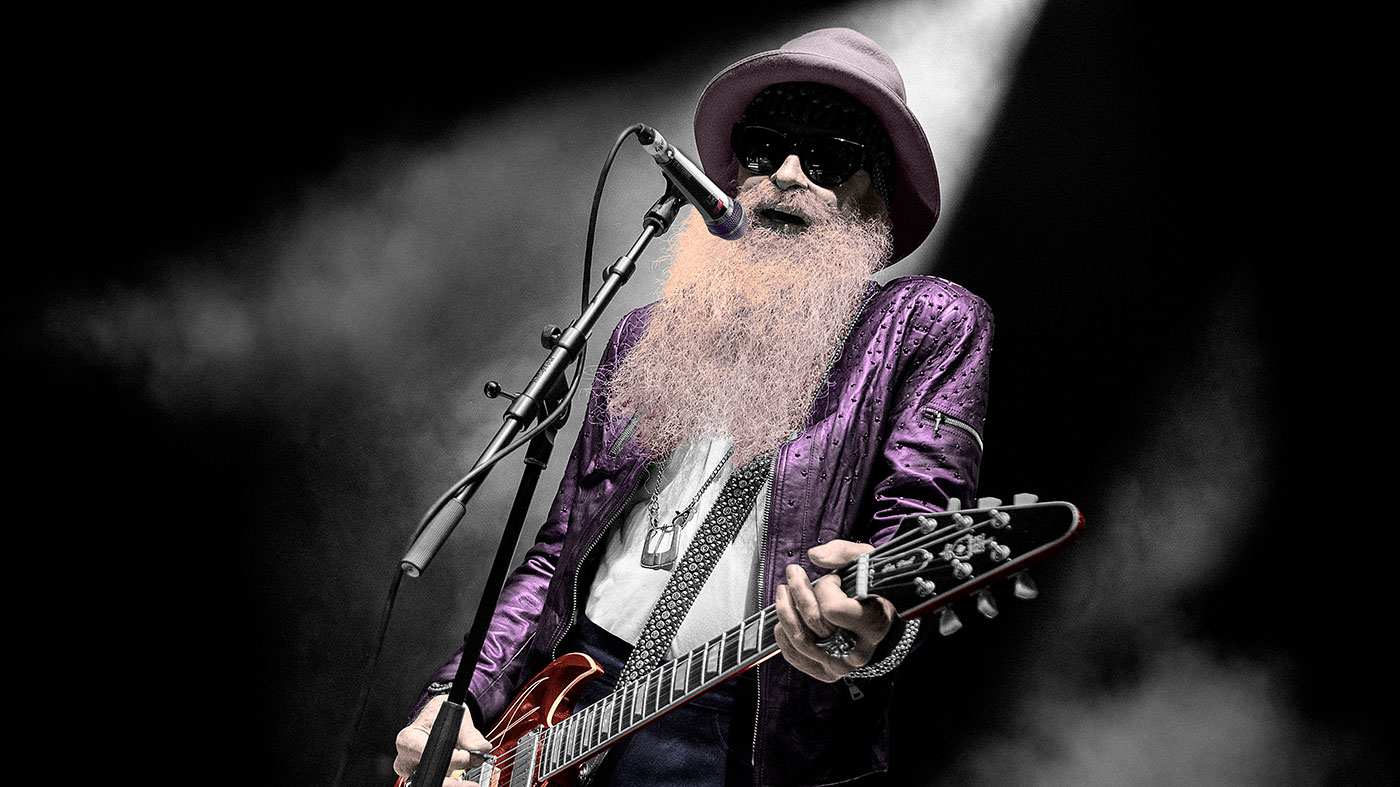6 songs guitarists need to hear by… ZZ Top
The greatest moments of Billy Gibbons

Formed in 1969 and with the original line-up still in place today, the legendary Texan trio have put their own stamp on the blues with a series of eminently listenable albums. Amongst their ranks is Billy F. Gibbons, one of the greatest living American guitarists.
Gibbons is a man who possesses oodles of style and levels of cool that are off the scale, not to mention one of the most revered guitar tones of them all. His incredible licks are a cornerstone of the band’s music and taking just a few on board will help your own playing immeasurably.
Here’s a sextet of that little ol’ band from Texas’ best moments.
1. La Grange –Tres Hombres (1973)
With Gibbons channelling the spirit of John Lee Hooker and backed by a simple rhythm tapped out on a snare rim, the intro ushers in a nigh-on perfect shuffle in A and once the band kicks notice just how tight the rhythm guitar parts are and how intimately they mesh with the bass and drums.
This proficiency doesn’t mean the music loses any of its soul though, and the listener will surely find that they’re still helplessly tapping their feet as the song shimmies along.
Gibbons brings out the pinched harmonics, altering their pitch by moving his pick along the length of the string, and his playing is a lesson in real control. It might be ‘just blues’, but it’s ZZ boogie blues and La Grange started the ball rolling for the band.
“Tres Hombres yielded our first Top 10 with La Grange [but] we had never played that song live.” Billy told us. “It was kind of a haphazard, last-minute thought that came together in all of three minutes. We were jamming out and at one point we looked through the glass and the guy was waving his arms, signalling us to continue on. The song just fell into place.”
Want all the hottest music and gear news, reviews, deals, features and more, direct to your inbox? Sign up here.
In something of a departure sections of the album were recorded in Memphis rather than Texas, at the famous Ardent Studios under the tutelage of producer Terry Manning. He had been at the desk when Led Zeppelin had recorded their third album there, and Stax legends such as Sam and Dave, Booker T and the MGs and Isaac Hayes were also regular visitors.
“It was the first record that was big and bold.” Comments Gibbons. “We were enjoying the benefits of that level of talent that lifted ZZ into a great-sounding group on record. It was no-holds barred and we dug it.”
2. Gimme All Your Lovin’ – Eliminator (1983)
The heaviness of the synthesizers created a nice platform that allowed the guitar to stand on its own
Billy Gibbons
In an attempt to freshen things up, the band made a conscious effort to wholly modernise not only their sound but their look too. MTV had ensured that visuals had become of vital importance to every artist at the time and, on the face of it, three somewhat weathered Texan bluesmen weren’t necessarily the stuff of teenage dreams.
However, thanks to a slew of near-perfect videos in which the trio play up to their cartoony image, happy to allow a hot car (a customised 1930s Ford Coupe part-built by Gibbons himself) and even hotter women to attract all the attention, mainstream popularity and, ultimately, massive worldwide success was assured.
The music was magnificent too and had been both augmented and tightened by synths and sequencers. With a huge guitar tone bubbling under Gimme…’s verses and sprinkled with expertly-judged treble-string stabs, the melody and impossibly catchy chorus couldn’t miss, and the wonderfully frugal guitar solo merely confirms Billy’s genius.
“Gimme All Your Lovin’ started with the music.” Billy told us. “The heaviness of the synthesizers created a nice platform that allowed the guitar to stand on its own. The synths could play an octave below a bass guitar so there was a full bed of sound that contrasted with my guitar parts."
The album went on to sell over 15 million copies and it still sounds great today.
3. Beer Drinkers & Hell Raisers –Tres Hombres (1973)
Another solid track from this great album, one that raises a glass to the clienteles of the countless bars within which ZZ had cut their teeth. It’s also a song of particular significance in the evolution of the electric guitar as the studio version features Gibbons fretting notes by hammering on the fretboard with his right index finger, captured quite possibly for the first time on a popular rock record.
I held the low fret down and tapped the high octave, and that did it
Billy Gibbons
It was “totally by accident," Gibbons told Guitar Player in 2006. "As Frank Beard – our man with no beard - waited for the tape to roll, I was attempting to illustrate with Dusty the high note for the bass-guitar track. I held the low fret down and tapped the high octave, and that did it. Dusty leaned back and said, “Man, do that and do it again!
“It's still in the technique corral. Van Halen made it a regular thing, and now it’s a genuine part of the player’s approach to shred. I dig it. Of course, I liked what Eddie [Van Halen]'s addition brought about, including a lot more lines inside the technique. We realised we were spirits of a kindred kind.”
While there’s little doubt that Edward Van Halen brought the technique well and truly into the mainstream with Eruption in 1978, the fact that Billy had already incorporated it into his own armoury speaks volumes and a delve into You Tube will allow you to uncover a shaky live video of Halen covering Beer Drinkers… on stage in 1984; a truly momentous meeting of minds.

The remainder of the guitar solo certainly brings Eric Clapton’s tone and phrasing to mind as Billy adding touches of Cream to his established melange of Texas hot sauce 12-bar and, as he stretches out towards the song’s climax, he pulls off one wonderful lick after another.
EVH wasn’t the only player to appreciate Billy’s technique. Queen’s Brian May, whilst on tour in the US in 1977, came across a band in a Houston bar whose guitarist would, as Brian describes it, “…do this thing where he would play a note, bend it up and whack his right hand onto a fret to make it sing up the top. I was entranced, so I went up to him afterwards and he said that he’d got it from Billy Gibbons.”
May used the technique on the Queen track It’s Late and was yet another homage, albeit a convoluted one, to the far-reaching influence of the Texan.
4. Tush – Fandango! (1975)
ZZ make no bones about the fact that soundcheck jams would sometimes result in great songs and they came up with this ode to the merits of either something lavish or ladies bottoms, depending on who you believe, before a gig in Alabama.
It’d be fair to say that just about every guitarist has come up with a riff that resembles this to a certain extent but notice how Billy uses his thumb to slide up to the root on the low E rather than simply including the note as part of a power chord; it sounds simple but it really isn’t.
The chord inversions he uses at the turnarounds raise the whole thing up to another level, while the slide solo is beautifully restrained and perfectly in tune.
“Confidence was building when we were recording Fandango!.” Billy told us in 2016. “We were enjoying the rewards. We were thinking most about the free beer and girls that we were enjoying. Then the importance of paying close attention in the studio and getting serious about tuning and timing started to sink in.”
Tush was their most successful pre-Eliminator single and led to one of the most outrageous spectacles in rock history, the 1976/77 Worldwide Texas tour. Strutting their stuff on a custom 75ft wide stage shaped like the state of Texas the band took all manner of local fauna along for the ride, sharing the spotlight with live buffalo, long horn cattle, rattlesnakes and buzzards.
“It was crazy.” Drummer Frank Beard wryly comments, and he’s not wrong.
5. Jesus Just Left Chicago – Tres Hombres (1973)
There’s always time for a slow blues and, as soon as the band launch into this on stage, the place always goes nuts. Set in the key of G the construction is sufficiently removed from standard thanks to some extra measures and an A chord that’s thrown in just before the turnaround, and Gibbons takes time out at the end of each verse to go to town, emotively bending strings and merging licks for all he’s worth.
An error by a studio staffer caused the preceding track on the album, Waitin’ For The Bus, to run straight into Jesus… but, as Billy explains, they left well alone as this unintentional amalgamation of the two songs sounded good.
“That segue was a fortunate miscalculation by the engineer,” he clarified to Classic Rock Revisited. “He had been attempting to splice out some blank tape, and the result is that the two come off as a single work. It just seemed to work."
On record Gibbons would lay down rhythm guitar tracks to underpin proceedings, something that’s not possible to recreate on stage; he’s only got one pair of hands after all.
With the live clip we’ve chosen below notice how Dusty Hill’s massive bass sound fills the music out, especially when Gibbons takes his solos. Bass tech Ken Gordon has described the tone as “Texas blues with a little nastiness and a lot of whooo!” and it’s perfectly apparent here just what he means.
6. I’m Bad, I’m Nationwide – Degüello (1979)
A track that demonstrates the disparate sonic layers the band would build up, subtleties that could be lost in the full roar of a ZZ live show. From the outset the guitar embellishments that ride over a meaty rhythm have a unique character to them and the zingy overtones during the syncopated stabs come from a bandolón, a mandolin-like Mexican instrument. The solos also featured something unexpected, as Billy explained to Guitar World.
"The lead track was played on a custom-made, half-sized, short-scaled guitar tuned to G. It was actually standard tuning cranked up three steps, which remained quite playable thanks to the short scale.”
The extended solo workout sees Billy firing off palm-muted octaves at will and, as ever, his choice of notes contrasts nicely with those of the rhythm track. Then the tempo shifts up a gear and the bass and guitar glue themselves together through a series of mesmerising runs while Billy indulges in a lead duel with himself, one side of the battle fleshed out with a Maestro OB-1 Octave Box.
This was the first album the band recorded for new label Warner Bros and Degüello, which can be loosely translated into English as colloquially meaning ‘to give no quarter’, is a pretty dark title; the word was used as a rallying cry by Mexican forces during the Battle of the Alamo in 1836, re-emphasised by the cover artwork depicting bullets ripping through a white flag. Great song, though.
Simon Bradley is a guitar and especially rock guitar expert who worked for Guitarist magazine and has in the past contributed to world-leading music and guitar titles like MusicRadar (obviously), Guitarist, Guitar World and Louder. What he doesn't know about Brian May's playing and, especially, the Red Special, isn't worth knowing.
